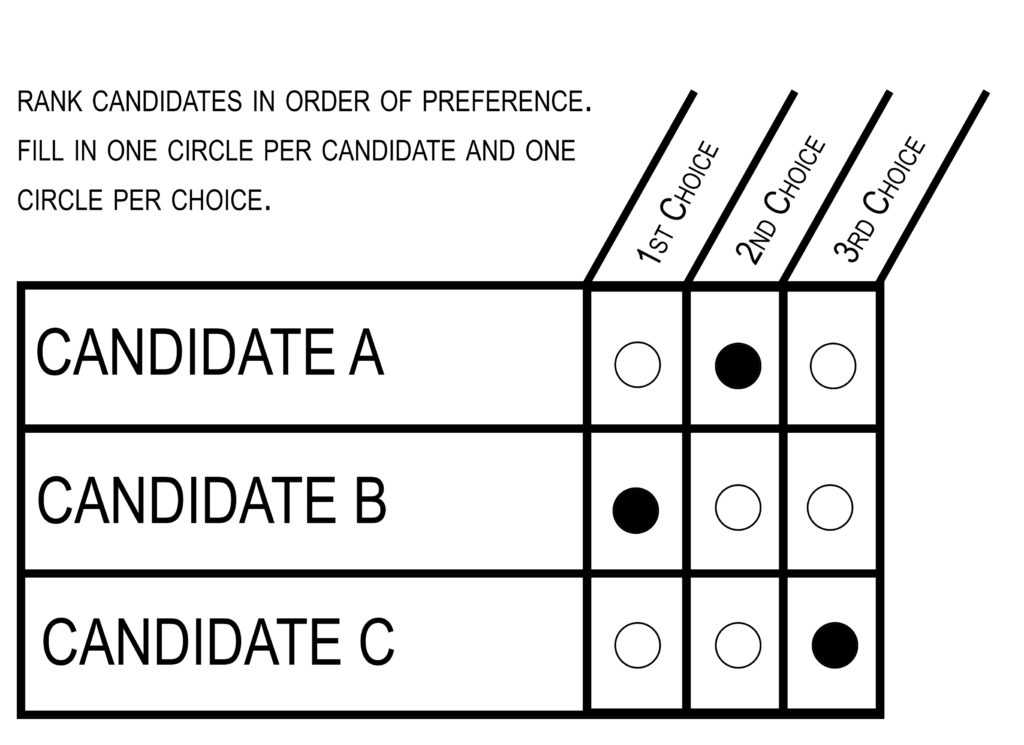Ranked choice voting makes our democracy work better. It’s a simple way to ensure that elections are fair for all and that winners have the support of a majority of voters.
How Does Ranked Choice Voting Work?
Ranked choice voting (RCV) allows voters to rank candidates in order of preference: first, second, third, and so on. If your vote cannot help your top choice win, your vote counts for your next choice. This process continues until there is a majority winner — a candidate who wins at least 50% plus one of the votes.
This creates a system where the idea of a ‘wasted vote’ doesn’t exist and ensures that the winning candidate has the support of a true majority of voters.

Benefits of Ranked Choice Voting:
- Ranked choice voting elects majority winners even when more than two candidates run for office, which protects democracy and better the reflects the will of the voters. Under existing law, a “winner” might actually be the candidate the majority of the voters consider to be the WORST choice. RCV ensures majority rule, rather than simply allowing the candidate with the highest vote total in a multi-candidate race to win.
- Ranked choice voting eliminates the spoiler-candidate effect. Unlike our current electoral process of plurality rule, voters do not feel pressured to strategically select frontrunner candidates or risk their votes being wasted. With RCV, voters can select their favorite candidate, even if they seem unlikely to win. If their first choice is eliminated, voters still get a say in who governs them. Voters are free to vote on principle instead of strategy; voting FOR their preferred candidates instead of AGAINST their least preferable candidate, regardless of how others may vote.
- Ranked choice voting promotes more diverse candidates and winners. Because candidates are not discouraged from running at the risk of being a “spoiler”, RCV is a system that invites greater participation from more diverse candidates. Recent studies have found that RCV increases the percentage of BIPOC and female candidates seeking office, and that the victors of these elections tend to better reflect their constituency, resulting in these underrepresented populations winning more offices.
- Ranked choice voting discourages negative campaigning and rewards candidates who build consensus and broad appeal. Because candidates are also competing for voters’ second-choice votes, often from opponents’ supporters, the incentives for highly negative campaigning and personal attacks are reduced. Candidates are encouraged to reach out to voters beyond their typical base.
- Ranked choice voting increases voter participation and saves taxpayer money. For example, under current law in Burlington, if the plurality winner of an election does not receive at least 40% of the vote, a runoff election is held. Runoff elections require all of the costs and burdens of a separate election, but voter participation is usually much lower and of course, the results of the election come much later. RCV prevents all of these issues.
What’s happening in Vermont?
In 2021, VPIRG helped lead the Better Ballot Burlington campaign to make democracy more fair and functional in Vermont’s largest city.
On Town Meeting Day, Burlington voted resoundingly in favor of a better ballot. Ballot Question 4, a charter change to adopt ranked choice voting for city council elections passed decisively with 64 percent of the vote, and with nearly 4,000 more ‘yes’ votes than ‘no’ votes. If approved by the legislature, the measure will take effect in 2022.
As we look towards the future, we have a goal bringing ranked choice voting and its benefits to statewide elections in 2024.
